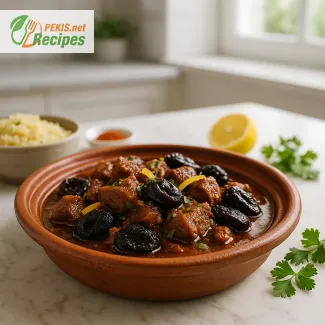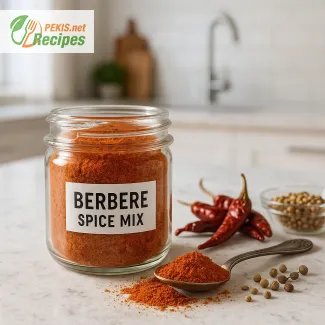For 4 servings, this Berbere chicken is a flavorful, spicy dish featuring Berbere spice mix, chicken thighs, and aromatic ingredients like onion, garlic, and ginger. With a prep time of 15 minutes and a cooking time of 30 minutes, the chicken simmers in a rich, spiced sauce made with tomatoes, lemon juice, and water. It's perfect for a hearty meal and can be stored for up to 3 days in the fridge. The dish brings the bold flavors of Ethiopia to your table with minimal effort.
Creating this Berbere chicken recipe came naturally after years of working with spices from around the world and understanding how heat and aroma can transform a dish. The goal was to capture the depth and warmth of Ethiopian cuisine while keeping the process simple enough for everyday cooking. The first time this blend of Berbere spices, tomatoes, and garlic came together, the kitchen filled with a rich, smoky scent that immediately brought comfort and curiosity in equal measure.
Cooking with Berbere means finding balance—spice without overpowering, warmth without bitterness—and this version captures that perfectly. It’s all about layering flavors and letting them develop slowly, creating a dish that’s bold, inviting, and deeply satisfying.
PEKIS – a professional chef and recipe developer with over 25 years of experience in cooking and baking, specializing in European and international cuisine.

Exploring the Soulful Heat of Ethiopian Berbere
Where Spice, Tradition, and Flavor Come Together
Few spice blends tell a story as vividly as Ethiopia’s Berbere. Deeply rooted in the Tigray region, this fiery red seasoning captures the essence of Ethiopian cooking — a balance of warmth, aroma, and complexity. Its power lies not just in its heat but in its ability to transform any dish into something soulful and unforgettable. From the first whiff of paprika, cayenne pepper, and ginger, to the lingering sweetness of cinnamon and clove, Berbere evokes both comfort and intensity in every bite.
The Essence of Tigray’s Culinary Heritage
Across Ethiopia, Berbere is more than a spice mix — it’s a cultural thread. Generations have passed down this blend, adjusting the balance of heat and fragrance to suit local traditions. Each region, family, and cook adds a unique touch: some prefer the bold kick of cayenne, others emphasize the earthy undertone of fenugreek or the floral hint of cardamom. What unites them all is the love for a spice that turns even the simplest meal into a celebration of flavor and heritage.
The heart of Berbere’s magic lies in its versatility. It’s the foundation for many beloved dishes like Doro Wat (a rich chicken stew) and Misir Wat (spiced lentils). But beyond Ethiopia, chefs and home cooks alike have adopted it as a way to add depth and heat to meats, vegetables, and even grains. Its layered complexity — both spicy and aromatic — makes it one of the world’s most intriguing seasoning blends.
Key Components That Define Its Flavor
The foundation of Berbere spice is built upon a carefully balanced mix of several core ingredients:
- Paprika provides a deep red color and mild sweetness.
- Cayenne pepper contributes the heat that defines Berbere’s fiery kick.
- Garlic and ginger add freshness and earthy warmth.
- Cinnamon, clove, and cardamom bring sweetness and complexity.
- Fenugreek and black pepper ground the flavor with subtle bitterness and depth.
This intricate combination creates a spice mix that’s both bold and balanced, capable of enhancing nearly any savory dish.
Why You’ll Love This Recipe
- Rich, complex flavor that adds warmth to every meal.
- Adaptable for meats, vegetables, grains, and even sauces.
- Authentic Ethiopian heritage, bringing culture to your kitchen.
- Easy to store and use for quick flavor boosts.
- Vibrant color and aroma that elevate both taste and presentation.
Origin and Cultural Significance
Berbere traces its history to ancient trade routes connecting Ethiopia to India, the Middle East, and North Africa. These exchanges brought exotic spices that merged with local chili peppers and herbs to create something uniquely Ethiopian. Over time, the spice became inseparable from national identity, appearing in religious feasts, family gatherings, and festive meals. Today, Berbere stands as a symbol of culinary pride — a bridge between Ethiopia’s past and its modern kitchens.
Storing and Preparing in Advance
Once blended, Berbere spice mix should be stored in an airtight glass jar away from sunlight and moisture. When kept in a cool, dark place, it retains its potency for up to three months. Making it ahead allows the flavors to meld and deepen, intensifying the aromatic complexity. For convenience, you can prepare larger batches — ideal for seasoning meat marinades, soups, or roasted vegetables on the go.
Practical Culinary Uses and Pairings
This spice mix pairs exceptionally well with a wide range of dishes. Beyond Ethiopian classics, it can be used to add vibrancy to:
- Grilled chicken or lamb, where its smoky aroma enhances the meat’s natural flavor.
- Vegetable stews, lending warmth to hearty root vegetables.
- Legume-based dishes, especially lentils and chickpeas.
- Roasted potatoes or sweet potatoes, creating a subtle caramelized crust.
- Homemade sauces, giving them depth and richness.
Creative Variations
While the traditional recipe remains timeless, small tweaks can create new and exciting versions:
- Add a touch of smoked paprika for deeper smokiness.
- Blend in turmeric for a golden hue and earthy note.
- Include dried basil or rosemary for a Mediterranean twist.
- Mix with olive oil or yogurt to create a quick marinade.
- Combine with lemon zest for a fresher, brighter aroma.
Each variation offers a new way to experience the bold spirit of Berbere, adapting the spice to different cuisines without losing its Ethiopian soul.
Related Recipe: How to Make Authentic Ethiopian Berbere Spice Mix at Home
If you want to prepare the traditional Berbere spice mix from scratch, explore the detailed recipe here:
How to Make Authentic Ethiopian Berbere Spice Mix at Home
The Modern Appreciation of Ancient Flavors
In today’s kitchens, Berbere represents the perfect blend of tradition and innovation. Its ingredients mirror the history of trade, travel, and cultural exchange that shaped global gastronomy. Modern chefs appreciate it not only for its flavorful punch but also for its story — a narrative of warmth, community, and shared meals. Each spoonful carries a reminder of Ethiopia’s rich landscape and its deep connection to food as a form of art.
The Berbere chicken recipe celebrates these elements beautifully. It invites you to slow down, appreciate the harmony of spices, and embrace cooking as an experience that connects people through taste, history, and tradition.
- Prepare the Chicken:
In a large bowl, coat the chicken thighs with olive oil and Berbere spice mix. Set aside and marinate for at least 15 minutes to allow the spices to infuse the chicken. - Cook the Aromatics:
Heat a large pan over medium heat. Add a splash of olive oil, then sauté the onion, garlic, and grated ginger for about 3–4 minutes until softened and fragrant. - Cook the Chicken:
Add the marinated chicken thighs to the pan and brown on all sides for about 5–7 minutes. - Add Tomatoes and Simmer:
Stir in the diced tomatoes, lemon juice, salt, and black pepper. Add water to the pan, cover, and simmer for 25 minutes or until the chicken is fully cooked through. - Serve:
Serve the chicken with the rich, spiced sauce from the pan, garnished with additional Berbere spice if desired.
FAQ questionWhat is Berbere spice mix?
Berbere spice mix is a traditional Ethiopian seasoning blend, made from a combination of paprika, cayenne pepper, garlic, ginger, cinnamon, and other aromatic spices. It’s known for its bold heat and complex flavor profile, which adds depth to a variety of dishes, from stews to grilled meats.
FAQ questionHow do you use Berbere spice in cooking?
Berbere is incredibly versatile and can be used in many ways. It’s typically rubbed onto meats like chicken, lamb, or beef, giving them a spicy, aromatic crust. You can also mix it into stews, sauces, and vegetable dishes for a rich, warm flavor. Its spicy heat can be adjusted based on how much you use, making it suitable for many tastes.
FAQ questionWhat are the benefits of Berbere spice?
The spices in Berbere offer numerous health benefits. Cayenne pepper boosts metabolism, while garlic has anti-inflammatory properties. Cinnamon aids in regulating blood sugar, and ginger helps with digestion. Overall, Berbere is not only flavorful but also packed with nutrients that support overall health.
FAQ questionCan I make Berbere spice at home?
Yes, you can easily make Berbere spice mix at home by combining paprika, cayenne pepper, ground ginger, garlic powder, cinnamon, cardamom, cloves, and a few other spices. Adjust the proportions to suit your taste preferences, whether you want more heat or a milder, sweeter flavor.
FAQ questionHow long does Berbere spice last?
When stored properly in an airtight container in a cool, dark place, Berbere spice can last for up to 3 months without losing its potency. However, for the freshest flavor, it’s best to use it within 1-2 months of making or purchasing it.
FAQ questionCan I use Berbere spice for vegetarian dishes?
Absolutely! Berbere works wonderfully with vegetarian dishes, adding a rich and spicy flavor to stews, vegetable roasts, and rice dishes. It pairs well with lentils, sweet potatoes, and chickpeas, bringing out their natural sweetness while balancing it with the bold spices.
Berbere spice mix brings the vibrant, complex flavors of Ethiopian cuisine right into your kitchen. With its perfect balance of heat and aromatic sweetness, it transforms simple dishes into bold, flavorful meals. Whether used in a chicken stew, rubbed onto meats, or added to vegetarian dishes, Berbere adds a unique depth that’s hard to match.
The beauty of Berbere lies in its versatility. From hearty meat dishes like Doro Wat to lighter vegetable roasts, it complements a wide range of ingredients, making it a staple in many kitchens. The rich blend of spices offers a wonderful flavor profile that works for both beginners and experienced cooks alike.
Once you’ve tried Berbere, you’ll find it hard to go back to bland meals. Its spicy heat and deep, aromatic undertones make it a perfect choice for anyone looking to experiment with new, exciting flavors. It’s not just a spice; it’s an essential element of Ethiopian culinary tradition, ready to elevate any dish.
For those looking to keep the flavors of Ethiopia at their fingertips, preparing Berbere in bulk is a great way to ensure you always have it on hand. Make your own blend and store it properly to keep the spices fresh and ready to use, so you can easily recreate this flavorful experience in your own kitchen.
Allergens Present in the Recipe:
- None
Gluten Information:
- Gluten-Free
Tips for Substituting Ingredients to Remove Allergens and Gluten:
- Olive oil can be replaced with any preferred cooking oil if necessary.
- Chicken thighs can be swapped with chicken breast for a leaner option.
- Vitamin C (mg): 12
- Iron (mg): 2.5
- Potassium (mg): 470
- Calcium (mg): 45
- Vitamin C supports immune health and skin integrity.
- Iron is essential for oxygen transport and energy production.
- Potassium helps maintain fluid balance and supports muscle function.
- Calcium is critical for bone health and muscle function.
- Anthocyanins (mg): 5
- Beta-carotene (mg): 0.8
- Flavonoids (mg): 20
- Anthocyanins help reduce oxidative stress and support heart health.
- Beta-carotene contributes to eye health and immune function.
- Flavonoids are known for their anti-inflammatory and anti-cancer properties.


